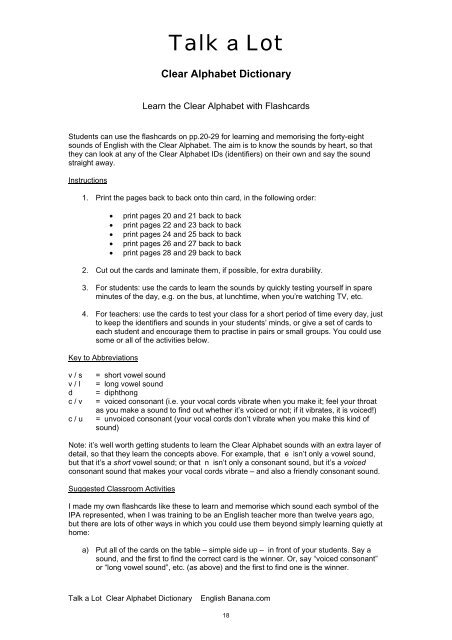14-Clear-Alphabet-Dictionary
You also want an ePaper? Increase the reach of your titles
YUMPU automatically turns print PDFs into web optimized ePapers that Google loves.
Talk a Lot<br />
<strong>Clear</strong> <strong>Alphabet</strong> <strong>Dictionary</strong><br />
Learn the <strong>Clear</strong> <strong>Alphabet</strong> with Flashcards<br />
Students can use the flashcards on pp.20-29 for learning and memorising the forty-eight<br />
sounds of English with the <strong>Clear</strong> <strong>Alphabet</strong>. The aim is to know the sounds by heart, so that<br />
they can look at any of the <strong>Clear</strong> <strong>Alphabet</strong> IDs (identifiers) on their own and say the sound<br />
straight away.<br />
Instructions<br />
1. Print the pages back to back onto thin card, in the following order:<br />
• print pages 20 and 21 back to back<br />
• print pages 22 and 23 back to back<br />
• print pages 24 and 25 back to back<br />
• print pages 26 and 27 back to back<br />
• print pages 28 and 29 back to back<br />
2. Cut out the cards and laminate them, if possible, for extra durability.<br />
3. For students: use the cards to learn the sounds by quickly testing yourself in spare<br />
minutes of the day, e.g. on the bus, at lunchtime, when you’re watching TV, etc.<br />
4. For teachers: use the cards to test your class for a short period of time every day, just<br />
to keep the identifiers and sounds in your students’ minds, or give a set of cards to<br />
each student and encourage them to practise in pairs or small groups. You could use<br />
some or all of the activities below.<br />
Key to Abbreviations<br />
v / s<br />
v / l<br />
d<br />
c / v<br />
c / u<br />
= short vowel sound<br />
= long vowel sound<br />
= diphthong<br />
= voiced consonant (i.e. your vocal cords vibrate when you make it; feel your throat<br />
as you make a sound to find out whether it’s voiced or not; if it vibrates, it is voiced!)<br />
= unvoiced consonant (your vocal cords don’t vibrate when you make this kind of<br />
sound)<br />
Note: it’s well worth getting students to learn the <strong>Clear</strong> <strong>Alphabet</strong> sounds with an extra layer of<br />
detail, so that they learn the concepts above. For example, that e isn’t only a vowel sound,<br />
but that it’s a short vowel sound; or that n isn’t only a consonant sound, but it’s a voiced<br />
consonant sound that makes your vocal cords vibrate – and also a friendly consonant sound.<br />
Suggested Classroom Activities<br />
I made my own flashcards like these to learn and memorise which sound each symbol of the<br />
IPA represented, when I was training to be an English teacher more than twelve years ago,<br />
but there are lots of other ways in which you could use them beyond simply learning quietly at<br />
home:<br />
a) Put all of the cards on the table – simple side up – in front of your students. Say a<br />
sound, and the first to find the correct card is the winner. Or, say “voiced consonant”<br />
or “long vowel sound”, etc. (as above) and the first to find one is the winner.<br />
Talk a Lot <strong>Clear</strong> <strong>Alphabet</strong> <strong>Dictionary</strong><br />
English Banana.com<br />
18



